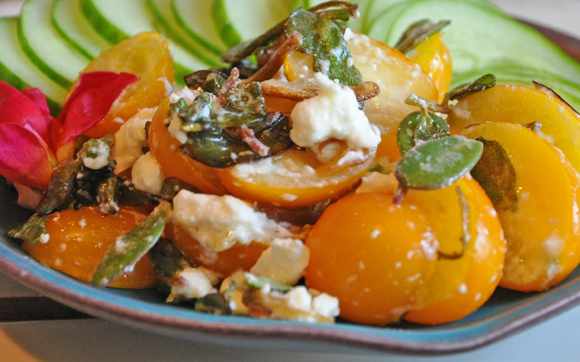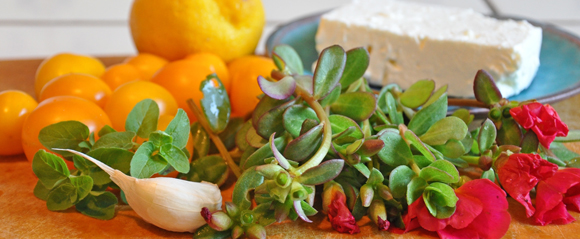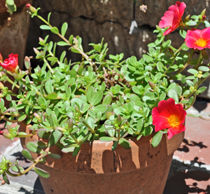June 18, 2025. Never heard of andrakla or purslane? By either name, it’s a succulent with small green leaves that’s now usually classified as a weed. Archaeological evidence shows it was widely used in the ancient Greek kitchen. It’s still a part of that cuisine, where it’s called andrakla and fried, then tossed with feta cheese, tomatoes and garlic.
Why should you care? It’s an ingredient that’s off-the-charts good-for-you. Purslane has more Omega-3 fatty acids than any other leafy vegetable plant – so much that its nutritional content is more like a fish than a land-based vegetable. The rest of its table of contents: vitamins A, B and C. Magnesium, calcium, potassium and iron. And betacyanins and betaxanthins, antioxidants now widely studied for their cancer-fighting effectiveness.
Where can you get some of this stuff?
It’s hard to find – but it’s incredibly easy to grow. It’s a weed, so it’s cheap. I bought a $2 seedling at the Farmers Market in May. Now it’s growing like a you-know-what. When I don’t harvest it fast enough, it sprouts beautiful red flowers at the end of each sprig. So I’m picking some every few days to toss, raw, into salads and other vegetable dishes. And frying it for the “other” Greek salad, like they’ve been doing in Greece for a few thousand years.
Andrakla Salad
I made two medium-size salads with:
1 cup of purslane
1 clove of garlic
1 cup of cherry tomatoes
1/2-cup of feta cheese, crumbled
2 teaspoons of olive oil
1 small wedge of lemon, juiced
3 sprigs of fresh oregano (optional)
1/2-cup of cucumber slices (optional)
Fry the purslane and garlic in 1 teaspoon of olive oil over low heat for 8 minutes. Stir in the optional oregano for 30 seconds, then remove the pan from heat. While your weeds are frying, slice the cherry tomatoes in half, crumble the feta and toss them with 1 teaspoon of olive oil and a squeeze of lemon.
Slice the optional cucumber if you want a traditional Greek diner touch. Toss the fried purslane with everything else and serve with or on the cucumber slices.
What do you get?
A slightly crispy crunch from the fried purslane. I left some raw, which gives you a resilient, springy crunch, more like a gentle pop. The flavor is mild: a very slightly salty, bitter green. For me, it’s the texture that’s really interesting and enjoyable. Especially with the slightly creamy, salty cheese. And the bright, sweet and acidic tomatoes. The fragrant garlic. And if you go for it, the clean, refreshing sweetness of the cucumber.
All this for just 160 calories per serving – almost all of it from the cheese and olive oil. And a glycemic load that’s near zero – which makes it a perfect dish for keeping weight off.
Is this a trend?
I’ve been growing purslane for a few years. Just this week my CSA farm share included a bunch.
Cost-Benefit Analysis
About $2 for a crisp, crunchy, creamy, intensely-flavorful salad that’s satisfying, refreshing, very low in calories and, more important, near-zero in Glycemic Load. Walk it off in 30 minutes.
Cost Comparison
The Classic Greek Salad at Daphne’s California Greek: $7.99. Four times more expensive than yours – and purslane’s not included.
All Calories Are Not Created Equal
“The results of our study challenge the notion that a calorie is a calorie from a metabolic perspective…. Many people can lose weight for a few months, but most have difficulty maintaining clinically significant weight loss over the long term … only 1 in 6 overweight and obese adults report ever having maintained weight loss of at least 10% for 1 year.
[One] explanation is that weight loss elicits biological adaptations—specifically a decline in energy expenditure (adaptive thermogenesis) and an increase in hunger—that promote weight regain. … a strategy to reduce glycemic load rather than dietary fat may be advantageous for weight loss maintenance and cardiovascular disease prevention.” Journal of the American Medical Association
Glycemic load?
First, there’s the ingredient’s Glycemic Index (GI): how quickly and how high it boosts your blood sugar. Then there’s the Glycemic Load (GL): how much of it is there to do the boosting. Vegetables and cheese: Slow. Carbs and sugar: Fast.
“You secrete insulin in response to the foods you eat — particularly the carbohydrates — to keep blood sugar in control after a meal. When your cells are resistant to insulin, your body (your pancreas, to be precise) responds to rising blood sugar by pumping out more and more insulin. Eventually the pancreas can no longer keep up with the demand or it gives in to what diabetologists call “pancreatic exhaustion.” Now your blood sugar will rise out of control, and you’ve got diabetes. “Is Sugar Toxic?“


